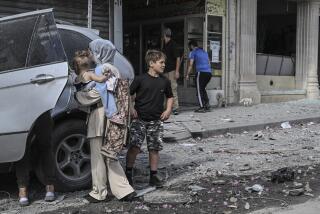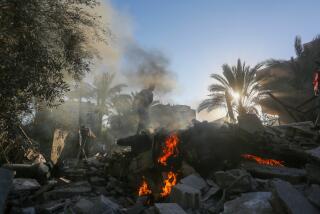PERSPECTIVE ON WAR : Civilians Are Off-Limits--Right? : Cheney must explain why populated areas of Iraq were deliberately bombed, a violation of international law.
- Share via
When Secretary of Defense Richard Cheney appears before the House Armed Services Committee on Wednesday, he can expect tough questioning about the Pentagon’s overdue report on the conduct of the Persian Gulf War.
Content to bask in selected video images of a near-flawless air campaign, the Pentagon has resisted scrutiny of its compliance with the laws of war. The report to Congress, which was due Jan. 15, provides a key opportunity to take the wraps off a disturbing fact that the Pentagon has been skirting: Nearly a third of the 2,500 to 3,000 civilian fatalities that were directly caused by allied air attacks could have been avoided had the allies adhered to international standards.
To prevent such needless deaths in future wars, the Pentagon should examine and acknowledge these breaches, beginning with Cheney’s testimony.
Over the past century, a body of international law has been developed to prevent the total warfare of the not-so-distant past in which civilians were deemed fair game for attack. The First Additional Protocol to the Geneva Conventions, with its detailed rules for minimizing civilian exposure to the hazards of war, is the leading codification of these laws of war. Although the U.S. government has not ratified the protocol, it claims to uphold most protocol standards as a matter of customary international law and has incorporated them into American military manuals.
For the most part, the allied air campaign against Iraq complied with these standards, in notable contrast to Saddam Hussein’s indiscriminate missile attacks on populated areas of Israel and Saudi Arabia. However, in several important respects, the allied campaign violated legal requirements in the choice of both the targets and the means of attack.
International law requires that all feasible precautions be taken to avoid civilian harm. One obvious way to fulfill this requirement is by ensuring that attacks on military targets in urban areas are launched at a time of day when the least number of civilians will be present. But in a series of attacks on Iraqi military targets in busy commercial districts, allied bombers struck during the day, when many civilians were present, and hundreds were needlessly killed. The Pentagon has offered no public justification for the timing of these attacks.
Similarly, the attack on the air-raid shelter in Baghdad violated the legal requirement that, whenever feasible, effective advance warning be given before attacking a civilian structure. Even granting the allied claim that the facility was being used as a military communications center, the Pentagon knew that the building had been used as a civilian shelter. The allies thus were required before attacking to warn civilians that the facility had lost its protected status. No public reason has been given why such warning was not issued. The result was the unjustified killing of 200 to 300 people, a great number of them mothers and their children.
In the course of the allied search for Iraqi missile launchers in western Iraq, civilian vehicles on the highways and Bedouin tents in the desert were repeatedly attacked. When Jordan protested, the Pentagon publicly denied that civilian vehicles were being targeted and suggested that allied pilots were able to distinguish civilian from military targets. Yet the attacks continued and scores of civilians died.
The Pentagon has given virtually no accounting of its use of precision-guided weapons. While these high-tech bombs and missiles were often far better than unguided weapons in avoiding civilian casualties, they accounted for a mere 8.8% of the munitions used. The Pentagon has said that precision-guided weapons were used in downtown Baghdad, where the few foreign journalists in Iraq were posted, but it has said nothing about other cities. The massive destruction in Basra, for example, suggests the use of less-advanced weaponry.
Particularly in light of the continuing embargo against Iraq, the Pentagon should also explain why it targeted numerous food, agricultural and water-treatment facilities, mostly near Basra. Since these civilian structures appear not to have been contributing to the Iraqi war effort, they should not have been attacked.
Similarly, the Pentagon should reveal whether the crippling of the Iraqi electric system, with its severe consequences for civilians, was exclusively for legitimate military purposes. Some Pentagon officials have suggested that part of the reason for destroying the electric system so completely was to demoralize the Iraqi population, in the hope that their desperation might lead them to overthrow Saddam Hussein. But attacks on civilian morale, for whatever reason, are illegal.
Rather than address these troubling issues, the Pentagon has remained smugly dismissive. Typical is Cheney’s comment last June: “If I had to do it over again, I would do exactly the same thing.”
International standards were the only thing that set the allied air campaign apart from Saddam Hussein’s conduct in that war. Cheney should ensure that both his testimony and the Pentagon report reflect the careful consideration and candor that these life-and-death matters deserve.
More to Read
Get the L.A. Times Politics newsletter
Deeply reported insights into legislation, politics and policy from Sacramento, Washington and beyond. In your inbox twice per week.
You may occasionally receive promotional content from the Los Angeles Times.










